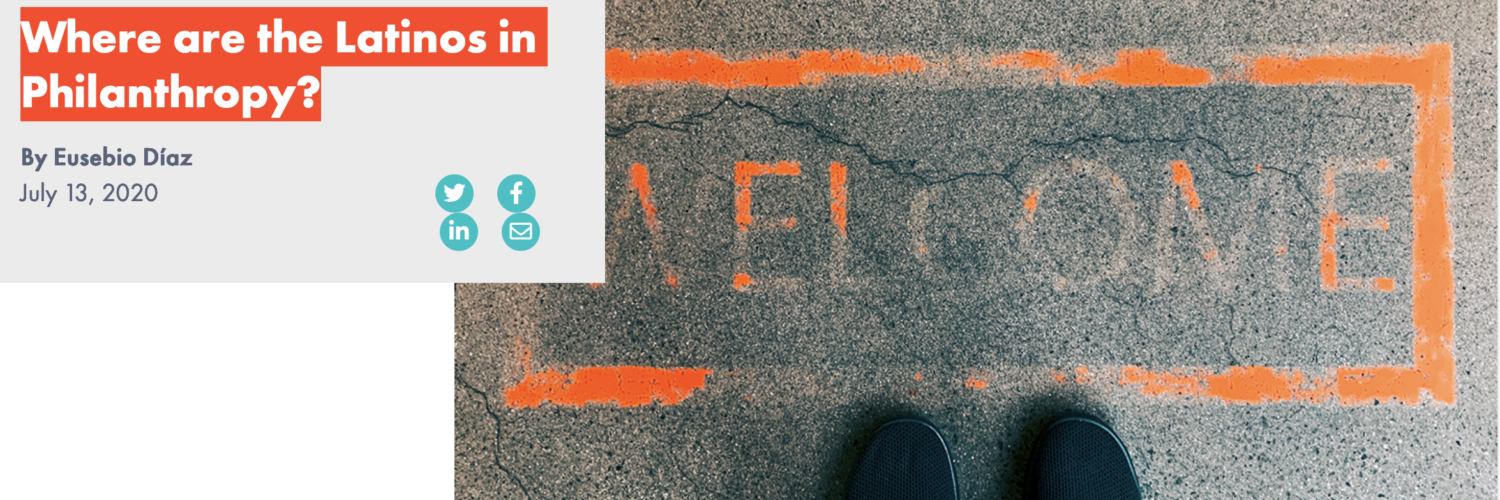
By Eusebio Diaz
EHF’s Chief of Staff
This post originally appeared in PEAK Grantmaking’s Insights
A few years ago, while attending a philanthropy conference in Atlanta, I participated in a site visit to the Centers for Disease Control. Having been to numerous philanthropy-related conferences over the course of my career, I wasn’t surprised by the lack of people of color in attendance. As we boarded the buses however, I was immediately aware that I was the only person of color on the tour.
If you’re white, this instant situational awareness might strike you as odd. If you’re black or brown, it won’t.
Upon arrival, we were guided towards the entry of the visitor’s center where we were directed to a security checkpoint, very much like a TSA airport checkpoint. As the line progressed, a security officer approached me and asked me to step out of line for a scan. He then proceeded to give me a pat-down and passed a security wand over my body. I stood in disbelief, fighting a rush of humiliation, as the other members of the tour party silently watched. After being cleared, I was allowed to continue through security and rejoin the group. The man who had sat next to me on the bus leaned in and said quietly, ‘Were you just racially profiled?!’ Yes. I was the only person of color on the tour, and the only one pulled from the line for a pat-down. The experience tainted my CDC visit and my participation in the conference.
I have experienced similar incidents in professional settings on several other occasions, including being mistaken for venue staff at more than one philanthropy-related event. It doesn’t take much to make me feel out of place at such events, as typically there are very few people who look like me in attendance. In fact, there are very few people who look like me in any decision-making and/or senior positions within the philanthropic sector.
Why, in 2020, is this the case and why has it continued to be the case?
In 2010, a five-year coalition of foundations was formed to address the ethnic and racial disparities in philanthropy. The D5 Coalition brought to light the glaring lack of diversity in the philanthropic sector, particularly at the leadership level, and issued a call-to-action sector-wide. At the end of the five-year effort, 2.3 and 10.2 percent of foundation CEOs and program officers, respectively, were Latinos. In 2010, Latinos represented 16 percent of the U.S. population. As this five-year effort came to a close in 2015, the glaring absence of Latinos and the failure of the philanthropy to effectively address the issue was painfully apparent.
Fast forward to today.
The Council of Foundations’ most recent annual survey (2019) of foundation staffing trends and data shows that Latinos currently occupy only 1 percent of foundation CEO positions, and hold just 9.3 percent of program officer positions.
Latinos, the largest minority group in the country, are projected to represent 20 percent of the population by the end of this year, yet Latino representation in key philanthropic positions within the sector has decreased since the formation of D5.
I frequently find myself the only Latino in the room where extensive conversations take place on issues that primarily affect Latinos. I speak only for myself here, but it is exhausting. During these closed discussions, Latinos are often treated enigmatically, as simultaneously both the solution and the problem on any given issue. We are referenced in monolithic and abstract terms, and rarely are tangible solutions created because the voices of the impacted and the those with the lived experiences to speak with authority and can speak their truths are entirely absent.
I often hear things like, ‘as go Latinos, so goes the country.’ It would stand to reason then that as go Latinos, so goes philanthropy as well.
There is a now infamous picture taken in 2017 at the White House during a roundtable discussion of a new healthcare bill, several aspects of which would dramatically impact women’s access to reproductive healthcare and maternity benefits, among other key issues. Not a single woman was present at that meeting. Many of us collectively laughed at the absurdity of this visual and mused in disbelief to our friends and colleagues. Yet, over in the world of philanthropy, where critical conversations are taking place and the decisions are being made that will dramatically impact the largest minority group in the country, we have closed the door and shut them out of the room.
We can no longer just hope for equity: Equity can only be achieved with the same level of vigorous intentionality that is used to create inequity. If your organization is not actively pursuing strategies to add diversity, and working towards realizing equity, ask yourself: Is it actively maintaining inequity?
